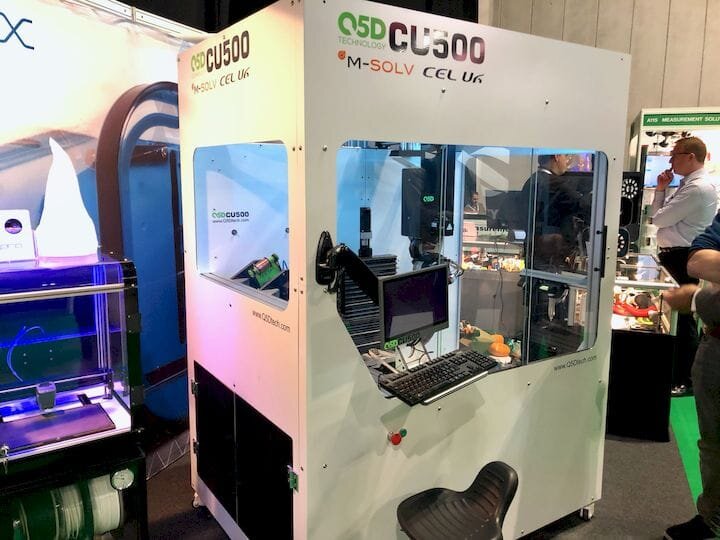![The Q5D CU500 3D industrial 3D printer [Source: Fabbaloo]](https://fabbaloo.com/wp-content/uploads/2020/05/image-asset_img_5eb08ecbcb67f.jpg) The Q5D CU500 3D industrial 3D printer [Source: Fabbaloo]
The Q5D CU500 3D industrial 3D printer [Source: Fabbaloo]
CEL-Robox is one of the longest operating desktop 3D printer companies, but now things seem to be changing.
CEL History
The company is small, but well-known due to their reliable equipment and fascinating 3D printing innovations. Over they years they have introduced a number of quite unique features.
One example of their innovation capability was the introduction of the “needle valve”. It was a specialized nozzle that included a pin that could be activated to immediately stop the flow of softened thermoplastic.
This valve essentially eliminated the problem of “stringies”, where passive drips from a hot nozzle became thin strands as the nozzle was moved from place to place during a print. While others toyed with complex retraction settings, the needle valve solved the problem directly.
Desktop 3D Printer Pivots
However, as we all know, the desktop 3D printing space is crowded, now more than ever.
Virtually all of the original desktop 3D printer manufacturers have pivoted their operations into other fields as they saw limited opportunities for growth after consumers realized there was no specific household use for the equipment.
Companies like MakerBot, Ultimaker, and others all changed their focus, sometimes gradually, and other times suddenly. Those companies that did not make a change tended to expire.
Thus I’ve always wondered about CEL-Robox. Would they pivot? Into what? There was no news of any change, until now.
Q5D Spin Off
And their pivot is a rather big one. While the company appears to have intent on selling desktop equipment, they’ve partnered with an electronics printing company, M-Solv, to produce an entirely new industrial machine under a spin-off company: Q5D.
The first product from Q5D is a fascinating device called the CU500, made during 18 months of secret development.
It’s a five-axis 3D printer, which, as astute readers may recall, can provide significant 3D printing advantages. Most specifically, the extra axes allow the print to be rotated in such a way as to never need support material.
But that’s just the start for the CU500, as it includes a number of revolutionary features.
CU500 Features
![3D print toolhead on the Q5D CU500 3D industrial 3D printer [Source: Fabbaloo]](https://fabbaloo.com/wp-content/uploads/2020/05/image-asset_img_5eb08ecc2b19f.jpg) 3D print toolhead on the Q5D CU500 3D industrial 3D printer [Source: Fabbaloo]
3D print toolhead on the Q5D CU500 3D industrial 3D printer [Source: Fabbaloo]
The five-axis motion system is organized around swappable toolheads.
The 3D print toolhead is only one of the available options for the CU500. There are several others, including milling heads for subtractive manufacturing. However, Q5D CEO Stephen Bennington explains that they aren’t used very much. One of the new toolheads, shown here, is a wire dispenser.
![Wire dispensing toolhead on the Q5D CU500 3D industrial 3D printer [Source: Fabbaloo]](https://fabbaloo.com/wp-content/uploads/2020/05/image-asset_img_5eb08ecc7809d.jpg) Wire dispensing toolhead on the Q5D CU500 3D industrial 3D printer [Source: Fabbaloo]
Wire dispensing toolhead on the Q5D CU500 3D industrial 3D printer [Source: Fabbaloo]
This tool can, by being swapped in at the appropriate moments during a 3D print job, literally embed normal conductive wire into a 3D print!
If that does not provide enough flexibility to introduce conductive elements into a 3D print, another toolhead can extrude copper paste, which, with some post-processing, can be made into conductive circuits.
Q5D Applications
![Non-layer 3D printing is possible with the Q5D CU500’s 5-axis motion system [Source: Fabbaloo]](https://fabbaloo.com/wp-content/uploads/2020/05/image-asset_img_5eb08eccb96a6.jpg) Non-layer 3D printing is possible with the Q5D CU500’s 5-axis motion system [Source: Fabbaloo]
Non-layer 3D printing is possible with the Q5D CU500’s 5-axis motion system [Source: Fabbaloo]
All of this means that the CU500 is a powerful device that can literally 3D print functional components, including circuitry.
Bennington explained that it would be possible to 3D print, say, an entire washing machine control panel.
![Circuit traces 3D printed by the Q5D CU500 [Source: Fabbaloo]](https://fabbaloo.com/wp-content/uploads/2020/05/image-asset_img_5eb08ecd0e9f8.jpg) Circuit traces 3D printed by the Q5D CU500 [Source: Fabbaloo]
Circuit traces 3D printed by the Q5D CU500 [Source: Fabbaloo]
However, in practice that might be not the approach used. Bennington said that a more efficient approach would be to start with some basic mass produced parts and then “print on top of them”, something the five-axis system could easily do.
Bennington believes the CU500 could produce wiring harnesses for about half the cost of traditional approaches.
Bennington feels that the CU500 might be ideal for several specific industries, including defence or aerospace, and I don’t doubt it, as the device seems ideal to produce electrically functional components.
There are some very interesting design features possible with the ability to embed wiring. For example, wires that might normally wear and cause shorts could be physically separated, deep in a 3D print. This could largely eliminate future electrical shorts situations as parts are used in the field.
CU500 Pricing
The CU500 doesn’t have a list price, as the units will be custom built for each client. That’s because the clients will require different combinations of toolheads as well as potentially different build volumes. However, when pressed, Bennington suggested the price could be in the £200K (US$245K) range.
The CU500 is an extremely interesting machine and is about as far away from a standard desktop 3D printer as you might go.
Via Q5D


1 comment
Comments are closed.